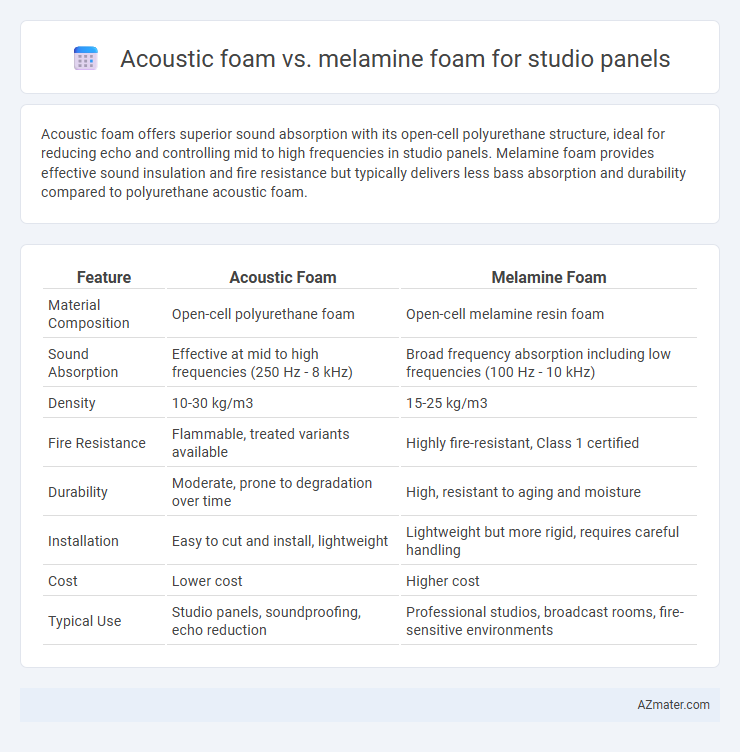Acoustic foam offers superior sound absorption with its open-cell polyurethane structure, ideal for reducing echo and controlling mid to high frequencies in studio panels. Melamine foam provides effective sound insulation and fire resistance but typically delivers less bass absorption and durability compared to polyurethane acoustic foam.
Table of Comparison
| Feature | Acoustic Foam | Melamine Foam |
|---|---|---|
| Material Composition | Open-cell polyurethane foam | Open-cell melamine resin foam |
| Sound Absorption | Effective at mid to high frequencies (250 Hz - 8 kHz) | Broad frequency absorption including low frequencies (100 Hz - 10 kHz) |
| Density | 10-30 kg/m3 | 15-25 kg/m3 |
| Fire Resistance | Flammable, treated variants available | Highly fire-resistant, Class 1 certified |
| Durability | Moderate, prone to degradation over time | High, resistant to aging and moisture |
| Installation | Easy to cut and install, lightweight | Lightweight but more rigid, requires careful handling |
| Cost | Lower cost | Higher cost |
| Typical Use | Studio panels, soundproofing, echo reduction | Professional studios, broadcast rooms, fire-sensitive environments |
Introduction: Importance of Studio Panel Materials
Studio panel materials significantly impact sound absorption and acoustic clarity within recording environments. Acoustic foam offers high-density polyurethane construction optimizing mid to high-frequency attenuation, while melamine foam features a lightweight, rigid open-cell structure providing effective broadband sound diffusion and thermal resistance. Choosing between acoustic foam and melamine foam depends on balancing soundproofing requirements, durability, and precise frequency treatment for enhanced audio fidelity.
Acoustic Foam vs. Melamine Foam: An Overview
Acoustic foam, made from polyurethane, offers excellent sound absorption for mid to high frequencies in studio panels, reducing echo and reverberation effectively. Melamine foam, a rigid and lightweight material, provides broader frequency absorption including lower frequencies, with superior fire resistance and durability in studio environments. Both materials enhance acoustic performance, but acoustic foam is preferred for targeted soundproofing, while melamine foam suits applications needing enhanced fire safety and structural stability.
Sound Absorption Performance Comparison
Acoustic foam and melamine foam differ significantly in sound absorption performance for studio panels, with acoustic foam offering superior low to mid-frequency absorption, effectively reducing echo and reverb in recording environments. Melamine foam excels in high-frequency absorption due to its open-cell structure, making it ideal for controlling high-pitched reflections and enhancing speech clarity. Studio panel design often combines both materials to achieve a balanced acoustic treatment across a broad frequency spectrum.
Fire Resistance and Safety Considerations
Acoustic foam typically features polyurethane or melamine-based materials, with melamine foam exhibiting superior fire resistance due to its inherent low flammability and self-extinguishing properties. Studio panels made from melamine foam conform to stringent fire safety standards like ASTM E84 Class A, reducing the risk of toxic smoke and flame spread compared to conventional polyurethane foams. Choosing melamine foam enhances overall studio safety by minimizing fire hazards while maintaining effective sound absorption performance.
Durability and Lifespan Analysis
Acoustic foam, typically made from polyurethane, offers moderate durability and a lifespan ranging from 5 to 10 years under proper care, with some degradation occurring due to UV exposure and humidity. Melamine foam is more rigid and resistant to heat, moisture, and chemical breakdown, providing a longer lifespan that can exceed 10 years in studio environments with consistent performance. In terms of durability, melamine foam is less prone to compression and maintains its acoustic properties better over time compared to softer acoustic foam panels.
Installation and Ease of Handling
Acoustic foam panels are lightweight and flexible, making them easy to cut, shape, and install with adhesive sprays or mounting tape, ideal for quick DIY setups. Melamine foam panels, while slightly more rigid, offer a firmer texture that maintains shape better during installation, requiring screws or brackets for secure mounting in professional studios. Both materials provide effective sound absorption, but acoustic foam's pliability enhances ease of handling and adaptable installation on irregular surfaces.
Cost-Effectiveness and Budget Implications
Acoustic foam offers a cost-effective solution for studio panels due to its lower price and ease of installation, making it ideal for budget-conscious projects. Melamine foam, while more expensive, provides superior fire resistance and durability, potentially reducing long-term replacement costs in professional studios. Choosing between acoustic foam and melamine foam depends on balancing upfront expenses with specific performance needs and safety requirements.
Maintenance and Cleaning Requirements
Acoustic foam requires gentle vacuuming and spot cleaning with mild soap to maintain its porous structure and sound-absorbing performance, while avoiding harsh chemicals that can degrade the material. Melamine foam panels offer easier maintenance due to their closed-cell structure, allowing for simple wiping with a damp cloth without risking damage or reduced effectiveness. Both materials benefit from regular dust removal to preserve acoustic properties, but melamine foam generally demands less intensive cleaning compared to traditional acoustic foam.
Aesthetics and Design Options
Acoustic foam panels offer a wide variety of colors and textures, making them highly customizable for studio aesthetics and interior design themes. Melamine foam panels typically present a more rigid, minimalist appearance with a fibrous texture, suited for modern or industrial studio designs. Both materials provide functional sound absorption, but acoustic foam extends greater versatility in visual integration and creative design options.
Choosing the Right Foam for Your Studio Panel
Choosing the right foam for your studio panel depends on your acoustic treatment goals and budget. Acoustic foam, made from open-cell polyurethane, effectively absorbs mid to high frequencies, making it ideal for reducing echo and flutter in vocal booths and control rooms. Melamine foam offers superior fire resistance and broader frequency absorption, including some low-frequency control, making it a durable choice for professional studios requiring stringent safety standards and enhanced sound clarity.

Infographic: Acoustic foam vs Melamine foam for Studio panel
 azmater.com
azmater.com